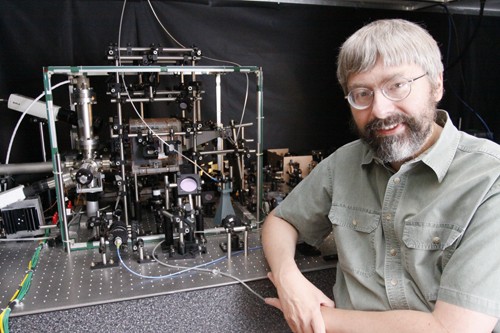UA scientists are the first to provide signs that the world is run by chaos — at least in the quantum world.
Quantum mechanics: the widely accepted set of mathematic principles that can predict pretty much everything on the smallest scale. In the world of atoms and molecules, quantum mechanics is the constitution to which all things are governed.
Now, switch to real life: cars honking, people walking, the wind blowing leaves around the base of a tree. In our world, there are no principles that can determine what career path we will take, what the stock market will do, or where you will eat lunch today.
Nevertheless, our day-to-day lives are governed by the physics principle of chaos — defined as small disturbances that completely change the end result. This is a concept physicists believe to only work in real life, known to them as the “”classical world.””
UA physicists have been pondering a couple questions: what is the connection between quantum mechanics in the quantum world and chaos in the classical world? How does the chaos we see in our daily lives emerge from the behaviors of atoms and molecules?
“”How can it be that we see chaotic behavior in everything: the weather, the stock market, the population of lemmings in the Arctic, and so on; but somehow it’s not built into quantum mechanics, which is our theory for how everything should behave?”” asked Poul Jessen, a professor in the College of Optical Sciences.
This question drove Jessen, along with a team of fellow scientists, to see if they could find signs of chaos in a model that is quantum mechanical, meaning it obeys all laws on the atomic level.
And what they found could take the study of quantum chaos to a whole new level, the team said.
In order to find the connection between quantum mechanics and classical physics, the team knew they had to start small — quite literally.
“”If you go out into the world to take a real-world model and try to find quantum chaos it’s impossible — you cannot control them at the quantum mechanical level,”” said Jessen. “”A scientist must have a solid model that obeys the rules of quantum mechanics.””
Atoms that act like individuals illustrate the simple quantum mechanic behaviors that Jessen and his team were looking for. To prepare the atoms, the team suspended them in a vacuum-like chamber with absolutely no air to ensure there would be nothing that the atom could collide with.
Because atoms move very quickly, the team “”cooled them down”” to 3 millionths of a degree Kelvin by a process known as laser cooling.
Even when the atoms are super cold, they are still like “”spinning tops,”” and scientists then measured their quantum state through a technique known as tomography, which is imaging through the use of a wave of energy, kind of like an X-ray machine.
Because atoms are magnetic, the team deliberately issued “”kicks”” by a pulsed magnetic field, and “”twists”” were delivered by an optical-frequency laser beam, and then were recorded as imaged and stop-and-go movies.
After observation of these images on a computer monitor, the team saw something truly amazing: the quantum “”spinning top”” atom actually has the same boundaries between predictability and chaos as the classical “”spinning top.””
On the computer monitor, the plotting of various atoms in a classical spin will move around in a shape that looks like onion layers. “”This shows you that the motion is predictable and regular,”” Jessen said.
However, if the initial spin was moved further away, you will go everywhere, and that is called the “”sea of chaos.”” Atoms spun infinitesimally off to one side followed a completely different pattern, which is a clear behavior of chaos.
And the quantum spin did the same thing. “”The spinning of the atom turns out to be a great model system for quantum chaos,”” Jessen said
“”This is one of the first examples of chaos in the quantum world,”” said Aaron Smith, graduate research associate in the physics department. “”After almost four years here in the lab, we have something pretty cool to show for it.””
“”Chaos usually doesn’t exist in the quantum world like it does in the classical world. But what we have done is show that although you can’t see classical chaos in the quantum world, you can see ‘fingerprints’ of it,”” Smith said.
Smith said the scientists are now looking to gain more control over the atoms in the experiment, meaning they would enlarge the “”spin”” and gain more insight to the evidence of chaos. “”The total space is actually two spins separated, and our original equipment only let us work with one spin and ignored the other. Now we’ve put in new controls so that will be the next step,”” he said.
The team said this experiment is a baby step toward understanding how quantum mechanics can be applied to both realms of physics — the very large and the very small.
“”This is basic science because it has to do with trying to understand how laws of physics are put together at a very fundamental level,”” said Jessen. “”This is something that will allow us to understand real life chaos — almost philosophically.””








